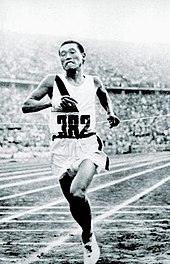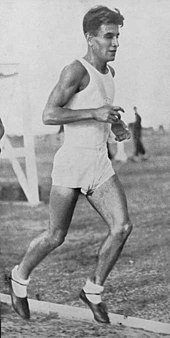1936 Summer Olympics / Athletics - Marathon (Men)
|
|
|||||||||

|
|||||||||
| sport | athletics | ||||||||
| discipline | Marathon run | ||||||||
| gender | Men | ||||||||
| Attendees | 56 athletes from 27 countries | ||||||||
| Competition location |
Olympiastadion Berlin (start and finish) |
||||||||
| Competition phase | August 9, 1936 | ||||||||
| Winning time | 2: 29: 19.2 h |
||||||||
|
|||||||||
|
|||||||||
The men's marathon at the 1936 Olympic Games in Berlin was held on August 9, 1936 in the Berlin Olympic Stadium. 56 athletes took part, of which 42 made it to the finish line.
The Olympic champion was Son Kitei of Korean origin , who was actually called his son Kee-chung and was forced to compete for Japan, which had annexed Korea, ahead of Ernie Harper from Britain . Bronze won Nan Shōryū , like Kitei a Korean-born athlete who had to run for Japan and whose correct name was Nam Sung-yong.
Existing records
- World best: 2: 29: 01.8 h - Albert Michelsen ( USA ), Port Chester , Port Chester Marathon , October 12, 1925 - World records are not held at this distance because of the different track conditions.
- Olympic record : 2:31:36 h - Juan Carlos Zabala ( Argentina ), Los Angeles , August 7, 1932
Routing
The starting point for the marathon course was the Olympic Stadium . After almost one round of the stadium, the route turned through the marathon gate to the city of Berlin . Over the Maifeld and it went right into the Angerburger Allee. Shortly afterwards the route led left into the Glockenturmstrasse and to the first checkpoint after four kilometers on the Havelchaussee . We continued along the banks of the Havel , the Grunewald on the left. The second checkpoint was at six kilometers on the Rupenhorn, two kilometers further on was the third checkpoint on the Schildhorn . The Grunewald Tower was reached after ten kilometers, at the level of the island of Lindwerder , the course headed southeast. At the end of the Havelchaussee, the route then turned left onto the AVUS . The course continued over the racetrack to the Nordschleife. There was the turning point, from which it went back on the same route through the marathon gate to the Olympic Stadium. The goal was reached after about 150 meters on the running track.
The race
August 9, 1936, 3 p.m.
Weather conditions: sunny, 21–22 ° C, little wind.
The 1932 Olympic champion Juan Carlos Zabala took the lead early on. By the 18-kilometer mark, he had extended his lead to over two minutes. Behind him followed the Portuguese Manuel Dias. The Briton Ernie Harper caught up, and the Japanese Son Kitei - actually son of Kee-chung (Korea) - followed suit. Zabala stumbled and fell after 28 kilometers. Kitei or Kee-chung took the lead together with Harper. Zabala had to give up the race shortly afterwards. At 35 km, however, the Japanese - actually Koreans - pulled away. Harper was able to keep Kiteis or Kee-chungs teammates Shōryū or Sung-yong in check and won the silver medal before him. The Olympic champion set a new Olympic record with 2: 29: 19.2 hours and was the first runner to stay below the two and a half hour mark at the Olympic Games.
In purely formal terms, this gold medal must actually be attributed to Japan. However, the correct name of the Olympic champion was actually son Kee-chung, and the country he came from was Korea, annexed by the Japanese . The award ceremony was like a tragedy, and the bronze medalist, like the winner, had to start under an imposed false name for the conquerors from Japan. Both demonstratively turned away when the Japanese flag was hoisted - a sad Olympic chapter that fitted into National Socialist Germany at the time.
Bottom line
literature
- Ekkehard zur Megede , The History of Olympic Athletics, Volume 1: 1896-1936, Verlag Bartels & Wernitz KG, Berlin, 2nd edition 1970, pp. 279f
Web links
- SportsReference Marathon , accessed September 19, 2017
- Official report pp. 644–647, engl. (PDF), accessed on September 19, 2017
- 1936, Marathon, Men, Olympic Games, Berlin , published August 1, 2013 on youtube.com, accessed September 19, 2017
Individual evidence
- ^ IAAF Statistics Handbook, Berlin 2009 Page 565 ( Memento from June 29, 2011 in the Internet Archive )
- ^ Official report p. 644, engl. (PDF)
- ^ Official report p. 646, engl. (PDF)
- ↑ Official report ( Memento of the original dated January 30, 2017 in the Internet Archive ) Info: The archive link was inserted automatically and has not yet been checked. Please check the original and archive link according to the instructions and then remove this notice. P. 606, engl. (PDF)
- ↑ Hoo Nam Seelmann: Olympic marathon champion Kee Chung Son. The saddest winner picture , NZZ from August 29, 2012, accessed on August 7, 2017.
- ↑ Unknown photos from Olympia 1936 , on tagesspiegel.de, created on August 12, 2012, accessed on August 7, 2017




